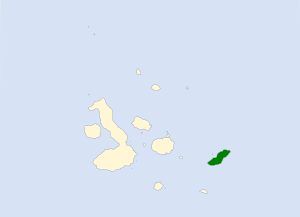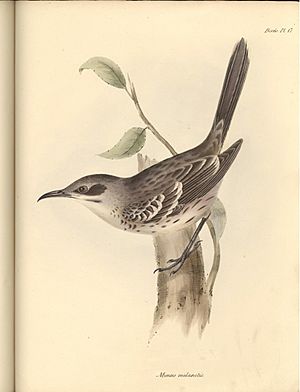San Cristóbal mockingbird facts for kids
Quick facts for kids San Cristóbal mockingbird |
|
|---|---|
 |
|
| Conservation status | |
| Scientific classification | |
| Genus: |
Mimus
|
| Species: |
melanotis
|
 |
|
| Synonyms | |
|
|
The San Cristóbal mockingbird (Mimus melanotis), also called the Chatham mockingbird, is a special type of bird. It belongs to the Mimidae family, which includes other mockingbirds. This bird is found only on San Cristóbal Island in the amazing Galápagos Islands. This means it is endemic to that one island, and you won't find it anywhere else in the world!
Contents
About the San Cristóbal Mockingbird
The San Cristóbal mockingbird is about 25 to 26 centimeters (10 inches) long. That's about the length of a standard ruler! Male birds are a bit heavier than females. Males weigh around 53 grams (about the weight of a small apple), while females weigh about 48 grams.
Adult mockingbirds have a thin white line above their eyes, like an eyebrow. They also have black patches near their eyes. Their head and back are grayish-brown with some darker stripes. Their wings and tail are dark brown. When their wings are folded, you can see two whitish bars. The outer feathers of their tail have white tips. Their belly is mostly whitish, with a light brown tint on their throat. They might have tiny dark spots on the sides of their chest and dark brown streaks on their sides. Young birds look similar to adults but have more streaks on their undersides.
Where San Cristóbal Mockingbirds Live
The San Cristóbal mockingbird lives only on San Cristóbal Island, which is in the eastern part of the Galápagos. These birds can be found in many different places across the island, from the coast all the way up to higher areas.
They like places like:
- Coastal mangroves (swampy areas with special trees)
- Open, dry lowland areas with small bushes
- Bushy woodlands with scattered trees and cacti
- Some taller woodlands
However, they do not like very dense forests or tall, wet woodlands, or open grasslands. They prefer areas where they can easily find food and build their nests.
How San Cristóbal Mockingbirds Behave
What San Cristóbal Mockingbirds Eat
San Cristóbal mockingbirds mostly look for food on the ground. Their main diet includes small insects and other creatures that live on land. They also enjoy eating fruits and berries from low-growing plants. Interestingly, these birds have even been seen picking ticks off Marine iguanas! This helps both the bird get a meal and the iguana get rid of annoying parasites.
How San Cristóbal Mockingbirds Display
Even though the San Cristóbal mockingbird doesn't have white patches on its wings, it still does a special "wing flash" movement. This is similar to what other mockingbirds do. The bird will run a short distance, then quickly open its wings about two-thirds of the way. After that, it extends them fully, holding them just above horizontal. This display might be used to show off to other birds or to warn off rivals.
San Cristóbal Mockingbird Reproduction and Life Cycle
San Cristóbal mockingbirds build their nests from January to April in lower parts of the island. In higher areas, they might nest a bit later. They usually keep a territory of about 3 to 5 hectares (7 to 12 acres) all year round.
They build a large nest made of twigs and lined with soft grasses. They usually place their nest in the fork of a tree, about 4 to 5 meters (13 to 16 feet) above the ground. A female bird will lay two to five eggs, but usually four. The female bird sits on the eggs to keep them warm until they hatch. Once the babies hatch, both parents work together to feed them.
San Cristóbal Mockingbird Songs
The San Cristóbal mockingbird sings a loud, beautiful, and unique song. It's a typical song for mockingbirds of its kind, and they use it to mark their territory and communicate with other birds.
Protecting the San Cristóbal Mockingbird
The IUCN (International Union for Conservation of Nature) has listed the San Cristóbal mockingbird as "Near Threatened." This means that while it's not in immediate danger, its population needs to be watched carefully. Before 2020, it was actually classified as "Endangered," which is a more serious level of threat.
The good news is that the bird's population is stable, and it's not currently facing immediate danger. Scientists estimate there are at least 20,000 adult birds. Protecting their unique island home is key to keeping their numbers strong.
See also
 In Spanish: Sinsonte de San Cristóbal para niños
In Spanish: Sinsonte de San Cristóbal para niños
- Galápagos mockingbird
- Floreana mockingbird
- Española mockingbird



